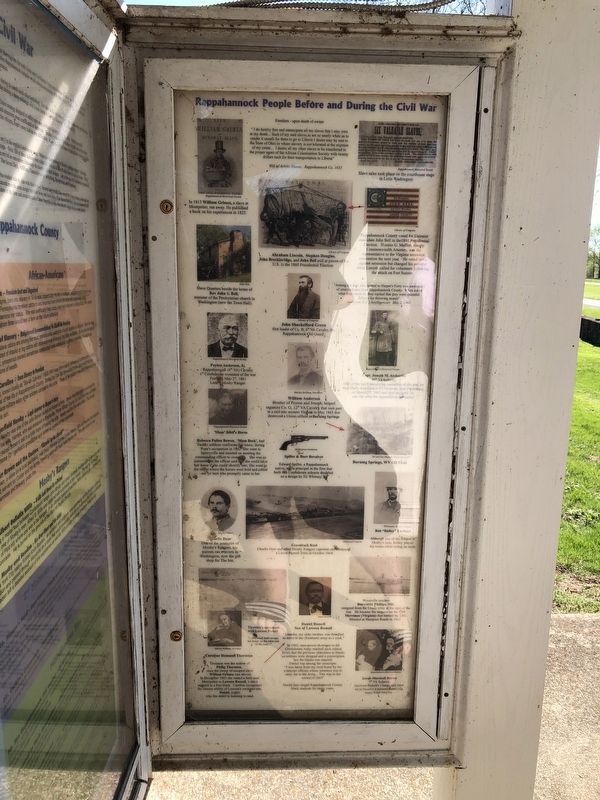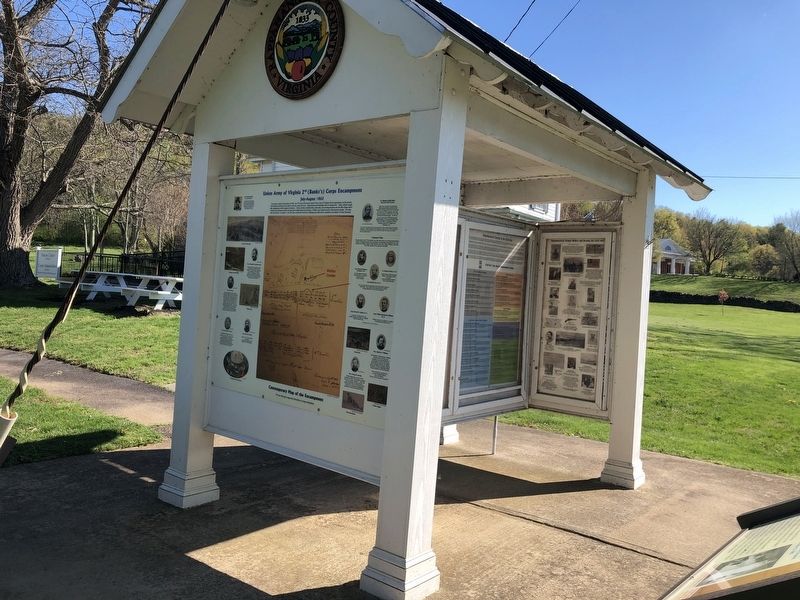Rappahannock People Before and During the Civil War

Freedom - upon death of owner "I do hereby free and emancipate all my slaves that I may own at my death… Such of my said slaves are so nearly white as to render it unsafe for them to go to Liberia I desire may be sent to the State of Ohio or where slavery is not tolerated at the expense of my estate… I desire all my other slaves to be transferred to the proper agent of the African Colonization Society with twenty dollars of each for their transportation to Liberia"
Will of Aylette Hawes, Rappahannock Co, 1833
Slave sales took place on the courthouse steps in Little Washington.
In 1813 William Grimes, a slave at Montpelier, ran away. He published a book on his experiences in 1825.
Rappahannock County voted for Unionist candidate John Bell in the 1860 Presidential Election. Horatio G. Moffett, county Commonwealth Attorney, was the representative to the Virginia secession convention the next year. He voted twice against secession but changed his position when Lincoln called for volunteers following the attack on Fort Sumter.
Abraham Lincoln, Stephen Douglas, John Breckinridge, and John Bell pull at pieces of the U.S. in the 1860 Presidential Election.
"Among the men who rushed to Harper's Ferry was a company of unarmed men from Rappahannock County. When asked what they could do, they replied that they were splendid fellows for throwing stones"
Anderson, (S.C.) Intelligencier, May 2, 1861
Slave Quarters beside the home of Rev John S. Bell, minister of the Presbyterian church in Washington (now the Town Hall).
John Shackelford Green first leader of Co. B., 6th VA Cavalry, the Rappahannock Old Guard
Peyton Anderson, Jr. Rappahannock (6th VA) Cavalry, 1st Confederate wounded of the war Fairfield, May 27, 1861. Later a Mosby Ranger.
Capt. Joseph M. Anderson, 49th VA Infantry. One of the last Confederate casualties of the war, he was fatally wounded at Ft. Stedman, near Petersburg, on March 25, 1865 and died on April 10, one day after the Appomattox surrender.
William Anderson. Brother of Peyton and Joseph; helped organize Co. G, 12th VA Cavalry that took part in a raid into western Virginia in May 1863 that destroyed a Union oilfield at Burning Springs
Rebecca Pullen Bowen, 'Mam Beck', had Yankee soldiers confiscate her horse, during Pope's occupation in 1862. She went up to Sperryville and insisted on meeting the commanding officer to campaign. She was so insistent that the officer said that she could have her horse if she could identify him. She went to the corral where the horses were

Spiller & Burr Revolver.
Edward Spiller, a Rappahannock native, was a principal in the firm that built this Confederate sidearm modeled on a design by Eli Whitney, Jr.
Bob "Ridley" Eastham. Although one of the wildest of Mosby's men, Ridley played his violin while riding on raids.
Charlie Dear. One of the youngest of Mosby's Rangers, his parents ran a tavern in Washington, now the gift shop for the Inn.
Greenback Raid. Charlie Dear and other Mosby Rangers captured and destroyed a Union Payroll Train in October 1864.
Woodville resident Dinwiddie Phillips, MD, resigned from the Union army at the start of the war. He became the surgeon on the CSS Merrimac (Virginia) that battled the USS Monitor at Hampton Roads in 1862.
Caroline Homasel Thornton. Thornton was the widow of Philip Thornton, once the owner of escaped slave William Grimes (see above. In December 1863 she rented a farm near Montpelier to Lawson Russell, a slave married to a free black. Caroline recognized the literary ability of Lawson's youngest son, Daniel, (right) who she aided in learning to read.
Thornton's agreement with Lawson Russell. "…L. Russell shall occupy her house on the other side of the road…"
Son of Lawson Russell
In 1865, man-power shortages in the Confederate Army reached such critical levels that the previous objections to blacks as soldiers were dropped and a conscription law for blacks was enacted. Daniel was among the conscripts. "I was taken from my rural home by the conscript officers whose intention was to carry me to the Army… This was in the winter of 1865."
Daniel later taught Rappahannock County black students for many years.
James Marshall Brown, 7th VA Infantry, survived Pickett's Charge and went on to become a minister marrying many local couples.
Topics and series. This historical marker is listed in these topic lists: African Americans • Churches & Religion • Industry & Commerce • War, US Civil. In addition, it is included in the Former U.S. Presidents: #16 Abraham Lincoln series list. A significant historical date for this entry is March 25, 1865.
Location. 38° 42.859′ N, 78° 8.831′ W. Marker is in Washington, Virginia, in Rappahannock County. Marker is at the intersection of Library Road (County Road 683) and Old Mill Road (County Road 683), on the left when traveling east on Library Road. Touch for map. Marker is at or near this postal address: 3 Library Rd, Washington VA 22747, United States of America. Touch for directions.
Other nearby markers. At least 8 other markers are within walking distance of this marker. Rappahannock County in the Civil War (here, next to this marker); The Rappahannock Old Guard (here, next to this marker); Union Army of Virginia 2nd (Banks's) Corps Encampment (here, next to this marker); Charles C. Nordendorf (here, next to this marker); Union Army of Virginia (here, next to this marker); Banks's Camp (here, next to this marker); Washington, Virginia (within shouting distance of this marker); A Tale of Two Mills (approx. 0.2 miles away). Touch for a list and map of all markers in Washington.
Additional keywords. human trafficking, slave trade
Credits. This page was last revised on April 18, 2021. It was originally submitted on April 18, 2021, by Devry Becker Jones of Washington, District of Columbia. This page has been viewed 329 times since then and 34 times this year. Photos: 1, 2. submitted on April 18, 2021, by Devry Becker Jones of Washington, District of Columbia.